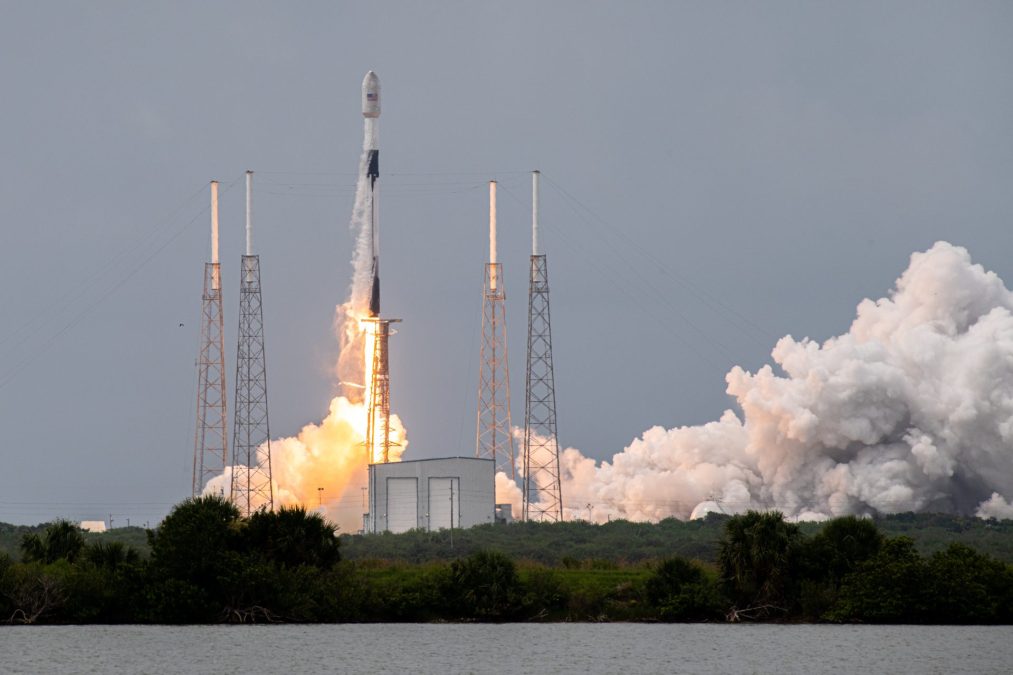New SDA, MDA missile-tracking satellites launched into space

Two sets of satellites from the Space Development Agency and Missile Defense Agency were launched together Wednesday as the organizations aim to demonstrate capabilities that could be used to detect and track adversaries’ hypersonic weapons and other advanced threats.
One batch includes four L3Harris-built systems that will complete Tranche 0 of SDA’s Proliferated Warfighter Space Architecture (PWSA), which will include a total of eight missile-tracking space vehicles and 19 data transport satellites on orbit.
Additionally, two Hypersonic and Ballistic Tracking Space Sensor (HBTSS) platforms — one built by L3harris and another by Northrop Grumman for the Missile Defense Agency — also went up.
Wednesday’s launch was slated for 5:30 PM EST from Cape Canaveral Space Force Station’s Space Launch Complex-40 in Florida. On Wednesday evening, SpaceX posted on the social media platform X that a Falcon 9 rocket “launched USSF-124 to orbit.”
The Pentagon plans to put the technologies through their paces this year to test their capabilities on orbit.
The effort comes as the U.S. military is looking for new tools to counter hypersonic missiles, which are designed to fly faster than Mach 5 and have unpredictable flight paths.
“The maneuverability and low flight altitude of hypersonic weapons could challenge existing detection and defense systems. For example, most terrestrial-based radars cannot detect hypersonic weapons until late in the weapon’s flight due to line-of-sight limitations of radar detection. This leaves minimal time for a defender to launch interceptors that could neutralize an inbound weapon,” according to a Congressional Research Service report.
New space-based sensors are seen as a solution to that problem.
The SDA missile-tracking spacecraft will be equipped with wide-field-of-view sensor payloads and optical communications terminals. The HBTSS systems will provide narrower, but more sensitive medium-field-of-view coverage.
Wide field of view “is intended to provide cueing data to HBTSS, which could then provide more specific, target quality data to a ground-based interceptor,” according to the CRS report.
“Space Development Agency’s wide field of view — think of that as broad surveillance in their tracking layer,” then-MDA Director Vice Adm. Jon Hill said last year during a budget briefing at the Pentagon.
“The role of HBTSS is to take a cue from either ground sensors or the wide field of view, to go to the smaller, medium field of view. So, think of that as now weapons control quality data. So, we go from broad tracking to now we need to put a weapon on, so you have to have a higher sensitivity. And that’s what HBTSS does,” he explained.
Senior SDA officials who briefed reporters ahead of the launch on condition of anonymity noted that the Tranche 0 systems are meant to serve as technology demonstrators, while subsequent tranches will provide “operational” capability.
“These two programs — [Tranche] 0 and HBTSS — have already inspired all of what we’re doing in Tranche 1 and Tranche 2. In Tranche 1, HBTSS payloads are a part of that program, which we’ll be launching in ‘25. And then in Tranche 2, we have several HBTSS-inspired designs, and other new capability as well. So what MDA has done with HBTSS has … enabled SDA to move forward and deliver missile defense capability to support intercept and [combatant commands] worldwide,” a senior SDA official said.
For the upcoming demos, Tranche 0 and HBTSS systems will be in the same “near equatorial” orbit, according to a senior SDA official.
Demonstrations of the satellites’ ability to detect and track are expected to occur during this calendar year when other Defense Department components test their own missiles.
“It’s just a matter of the launch windows coinciding with our satellites to be able to image those. So, we are actively working with all of our partners to be able to schedule those demos. And you’ll see those over the coming months here,” a senior SDA official said.
Flight tests of U.S. hypersonic missiles using all-up rounds are infrequent. For example, the Air Force has just one more test of its ARRW prototype slated for this year.
“I think that’s a fair assessment that there aren’t many of these, right? But that is the intent to be able to work with cooperative and noncooperative targets to be able to do our demonstration. So, we work very closely with all of our mission partners in terms of their planning for those activities. So, you know, we have insight and are able to plan accordingly,” a senior SDA official told DefenseScoop during the briefing with reporters.
The SDA and HBTSS systems won’t be optically connected on orbit for the demos. The cueing will take place via ground stations, according to a senior SDA official. However, these types of capabilities are expected to be more integrated in future tranches of the Proliferated Warfighter Space Architecture.
“In T1, we have HBTSS payloads on tracking layer buses, and they’re completely integrated into PWSA. So, they’re completely integrated at that time. And T2, we’ve got six more various types of payloads, but those are all integrated again. So moving forward, everything will be integrated,” the official told reporters.
Tranche 1 missile-tracking sats are slated to launch in spring 2025 and the Tranche 2 platforms are scheduled to go up in spring 2027.
In 2022, L3Harris and Northrop Grumman were awarded to build 14 systems each for Tranche 1. L3Harris, Lockheed Martin and Sierra Space were recently tapped to build and operate 54 satellites for Tranche 2.
Updated on Feb. 14, 2014, at 10:30 PM: This story has been updated to reflect that the SDA and MDA satellites were launched Wednesday evening.



